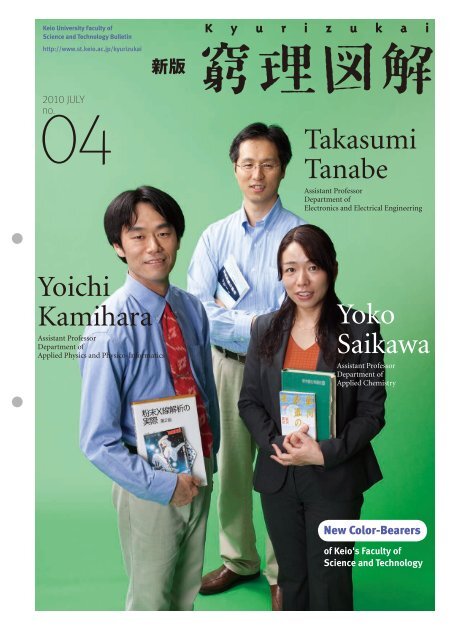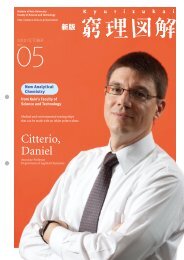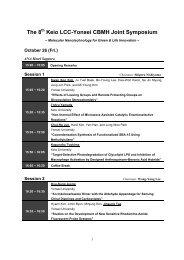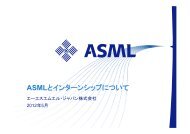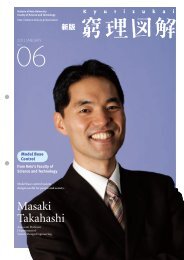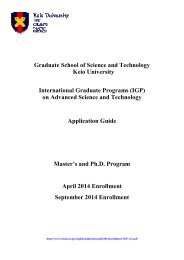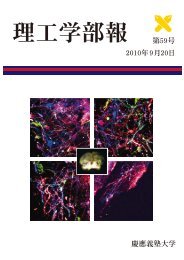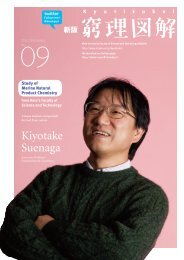Takasumi Tanabe Yoko Saikawa Yoichi Kamihara - Keio University
Takasumi Tanabe Yoko Saikawa Yoichi Kamihara - Keio University
Takasumi Tanabe Yoko Saikawa Yoichi Kamihara - Keio University
- No tags were found...
Create successful ePaper yourself
Turn your PDF publications into a flip-book with our unique Google optimized e-Paper software.
<strong>Keio</strong> <strong>University</strong> Faculty ofScience and Technology Bulletinhttp://www.st.keio.ac.jp/kyurizukai新 版2010 JULY04no.<strong>Takasumi</strong><strong>Tanabe</strong>Assistant ProfessorDepartment ofElectronics and Electrical Engineering<strong>Yoichi</strong><strong>Kamihara</strong>Assistant ProfessorDepartment ofApplied Physics and Physico-Informatics<strong>Yoko</strong><strong>Saikawa</strong>Assistant ProfessorDepartment ofApplied ChemistryNew Color-Bearersof <strong>Keio</strong>'s Faculty ofScience and Technology
Introducing the Researcher ❶Assistant Professor <strong>Takasumi</strong> <strong>Tanabe</strong> focuses on the development of photonic circuits, whichwill save the energy than electronic circuits.Developing Optical Microresonators to pavethe way to realize Photonic CircuitsToward a super energy-efficient societyBy using photons instead of electrons, photonic circuits can extremely decrease the powerconsumption of machinery and equipment. Optical microresonators are indispensablefor putting these photonic circuits to practical use, with which we can store light like amemory, release stored light whenever needed like a transistor or a switch, and changecharacteristics of light.<strong>Takasumi</strong> <strong>Tanabe</strong>Optical microresonatorsindispensable to optical circuitsPerhaps you have been surprised by theheat when touching your notebook PCpower adapter or the rear of a TV set. Thefact is, electrical appliances, regardless oftheir functions, are releasing wasted heatas part of the electricity they consume.For example, even gold, which hasexcellent electrical conductivity, exhibitssome resistance, not zero, and generatesJoule heat responding to the resistancewhen electricity is passed. In other words,by simply passing a current the electriccircuit loses heat energy proportional toits electrical resistance.“Electronic circuits are bound togenerate heat. But photonic circuits aretotally different. Light, when passedthrough glass, causes no loss like Jouleheat. Theoretically, photonic circuits workwithout loss,” explains AssistantProfessor <strong>Takasumi</strong> <strong>Tanabe</strong>.Capable of significantly reducingenergy consumption comparedwith ordinary electronic circuits,expectations are high for photoniccircuits as a solution to majorissues facing our modern society,such as conservation of energy andreduction of CO₂ emissions.With all advantages and noapparent shortcomings, but opticalcircuits actually come with theirproblems as well. One of them isthe development of a device thatcan confine light in one place.Negatively charged electronscan be kept in place by takingadvantage of the force of plus andminus attracting each other. Butlight does not have electric chargesas electrons do. So we need tocontrive an alternative method forstopping light in one place.“An optical microresonator isknown as a device to keep light inone place. The development of thisparticular device is essential forputting photonic circuits to practical use.If we can confine light in one place, thenit will become possible to use this opticaldevice as a memory. We can also use thesame device as a switch or a transistor bymanipulating the confined light. Amongseveral approaches attempted in thisstudy, I used photonic crystal technologyto confine light and succeeded in runningan logic circuit concerning computermemory.”Practical application, first . . .Having obtained positive results froma series of his studies, Dr. <strong>Tanabe</strong> tookup the challenge of practical applicationof photonic circuits from this spring. Hisresearch theme is the development ofan optical microresonator using silica,the main constituent of glass, as the rawOptical switchby opticalmicroresonatorLightinputsOpticalmemoryby opticalmicroresonatorCarrying informationby modulatinglight inputsSignal-codedlight outputsPassive photoniccircuit(Note: Sizes, etc. ofthe devices in theillustration are notaccurate.)Basic structure of the photonic integrated circuitOptical devices made of silica glass are arranged on thesilicon substrate. The disk-like devices in the upper left areoptical microresonators, in which light is trapped. With opticalmicroresonators, it is possible to vary refractive index accordingto the intensity of incident light, enabling the particular opticalmicroresonator to operate as an optical switch or an opticaltransistor. The device in the upper right is a passive device forbranching light signals. When light signals are sent from theoptical switch and/or optical transistor to this optical device, it cansort out the signals by wavelength or split the signals.material.“There are several reasons for choosingsilica as the raw material for my opticalmicroresonator. First occurring to mymind was silica's high compatibilitywith existing optical devices. Silica is anattractive material from the applicationviewpoint.”Devices required for a photonic circuitinclude the optical fiber cable andthe planar lightwave circuit. Of these,passive devices such as those used fortransmission of light signals and those forinformation branching are approachingthe level of practical use. And manyof these devices are silica-based. Inshort, if we succeed in developing anoptical microresonator with silica, wecan integrate into one chip such activedevices as the optical memory, opticalswitch and optical transistor as well asexisting passive devices, thus enabling anphotonic integrated circuit to becreated with ease.Furthermore, silica, whencompared with silicon which isthe raw material often used forphotonic crystals, has differentcharacteristics such as smalleroptical nonlinear coefficients andfaster nonlinear transition speeds.By using silica, it is also possibleto ascertain the influence that adifference in materials exercises ondevice functions.Dr. <strong>Tanabe</strong> expressed his hopessaying, “The use of silica as the rawmaterial enables us to re-examine,across the board, issues peculiarto the whole photonic integratedcircuit including peripheralequipment, rather than the opticalmicroresonator as a single device.I think the results and issuesidentified in this process will goa long way to further photoniccrystal and other photonic circuitstudies.”(Reporter & text writer:Kaoru Watanabe)2
Introducing the Researcher ❷Assistant Professor <strong>Yoko</strong> <strong>Saikawa</strong> investigates into and identifies materials responsible fornatural phenomena.Shedding Light on Various “Whys”in Our Daily LivesExplaining toxicity of a mushroom by chemical approachWhy is hippopotamus sweat red? . . . There are so many “Whys” in our daily lives and inthe world. Assistant Professor <strong>Yoko</strong> <strong>Saikawa</strong> of the Natural Product Chemistry Laboratoryinvestigates into materials responsible for a variety of natural phenomena. She recentlyidentified the toxic component of the poisonous Russula subnigricans mushroom.<strong>Yoko</strong> <strong>Saikawa</strong>The Russula subnigricans, popularlyknown in Japan as “Nise Kurohatsu”(see photo below), looks truly tasty butis actually a poisonous mushroom. Itwas first announced as a mushroom offatal toxicity during the 1950s. But ithas almost been forgotten because noaccidental deaths were reported duringthe ensuing 50 years and also becausethere are several other similar-lookingmushrooms.In July 2009 the British scientificmagazine Nature Chemical Biologycarried an article announcing that thepoison in Russula subnigricans mushroomis cycloprop-2-ene carboxylic acid.This achievement was the result of jointresearch with Dr. Kimiko Hashimoto(now Associate Professor at KyotoPharmaceutical <strong>University</strong>) as well aswith Professor Masaya Nakata and Dr.Masanori Matsuura (then student) ofthe laboratory, to which Dr. <strong>Saikawa</strong>belongs. In the world of natural productsinvestigation where almost all naturalsubstances have been thoroughlyinvestigated, this achievementhas become a significant topic ofconversation.Toxic substance that disappearsCycloprop-2-ene carboxylic acid isa small substance – a ring consistingof three carbon atoms, to whichcarboxylic acid is attached. “Sucha simple, small substance has longbeen left unidentified!” Dr. <strong>Saikawa</strong>talks about the surprise that struckher after years of investigation.Although its molecular structureis simple, its extraction was far fromeasy. The investigative study beganwith identification of the Russulasubnigricans mushroom. To evaluatethe toxicity, the team adoptedthe method of injecting the toxicsubstance into the peritoneal cavityof mice. But before long it becameHO 2 Cknown that mice would die even whennon-toxic substance was injected. Sothe experiment had to be done anew bychanging the policy to feed mice with thetoxic substance.The hardest problem encountered wasthat the toxic substance would disappearwhen an ordinary separation process wasemployed. Looking back over those days,Dr. <strong>Saikawa</strong> says, “We tried this way, andif it didn't work we didn't hesitate to takethat way. In that sense, research scientistslike us are quick-tempered.” The readinessto review and change research approachesas necessary and the toughness fordevising and carrying out new solutionsin rapid succession seem to be required.Finally, she found that the toxic substancedisappeared due to concentration, whichled to the improvement of the extractionprocess. Cycloprop-2-ene carboxylic acidwas thus identified as the culprit for theRussula subnigricans mushroom aftereight long years.HO 2 CHHCO 2 HHO 2 CHO 2 CCO 2 HHCO 2 HCO 2 HCO 2 HCycloprop-2-ene carboxylic acid and polymerizationRussula subnigricans (photo) had been the only fatallypoisonous mushroom the toxic component of whichremained unidentified. But the lethally toxic component wasfinally identified as cycloprop-2-ene carboxylic acid (the bluecircledpart in the upper left of the Fig.). When cycloprop-2-ene carboxylic acid molecules come closer to each other,polymerization takes place, which nullifies the toxicity. Thisexplains why the toxicity disappeared during the concentrationprocess of toxicity extraction. (Photo by <strong>Yoko</strong> <strong>Saikawa</strong>)Scales falling from her eyes –an exciting moment!“It was hard and depressing whenpositive results were not in sight. Butthe moment its structure was known,everything became clear and I foundall answers just before my eyes.” Oncethe structure of the toxic substance wasidentified, the question of the toxicitylost in the process of concentration wasnot a question at all. This excitinglyfresh feeling derived from achievementseems to drive Dr. <strong>Saikawa</strong> into scientificpursuit. From this particular researchproject, she could also appreciate the joyof discovery of the natural world.Discovery of new substances is alsoexciting as it allows her to pose newquestions to other scientific fields.The greatest feature of this particularpoison is that it causes “rhabdomyolysis”in which muscles melt. Since itsmechanism remains totally unknown,the achievement of her team is nowa focus of attention within medicalcircles.I spare no trouble findingnew seeds of research.As a research scientist, Dr. <strong>Saikawa</strong>is about to launch a research themeon her own for the first time. In thepast she frequented a zoo to samplehippopotamus sweat and climbedmountains many times in searchof the targeted mushroom. Fromsuch experience she says, “Seeds ofresearch themes are everywhere.But you can't find them if you'rejust sitting back watching TV orbrowsing through magazines. Theonly way is to use your own legs.” Tofind new research themes, she oftengoes out to sea as early as 4:00 inthe morning with a fisherman withwhom she recently befriended.(Reporter & text writer:Akiko Ikeda)3
Introducing the Researcher ❸Assistant Professor <strong>Yoichi</strong> <strong>Kamihara</strong>, who has discovered an iron-based high-temperaturesuperconductive material, proposes new possibilities.Creating Lossless Power TransmissionCables Using Iron-based High-TemperatureSuperconductive MaterialToward the ultimate electric linesSuperconductivity refers to a phenomenon in which electrical resistivity drops to zerowhen certain materials are cooled to low temperatures. It had long been believed thatsuperconductivity is a phenomenon peculiar to certain materials and it can hardly occur inmaterials containing iron. But Dr. <strong>Kamihara</strong> made a breakthrough in 2008 by discoveringsuperconductivity with a layered iron-based compound.<strong>Yoichi</strong> <strong>Kamihara</strong>Superconductivity with materialscontaining ironIn 1911 Heike Kamerlingh Onnesof the Netherlands discovered thatelectrical resistivity of mercury cooledto 4.2K (kelvin = the unit of absolutetemperature, 0K being -273.15 °C)drops to zero. The temperature atwhich electrical resistivity becomeszero is known as the superconductivitytransition temperature(Tc). Efforts inquest of materials that can becomesuperconductive at higher temperatureshave been made in the ensuing years.“Just a century has passed since thediscovery of superconductivity, duringwhich time a number of superconductivematerials have been identified. Thesematerials are roughly divided into metalbasedcompounds and cuprate-basedones. In terms of transition temperature,39K for MgB₂ discovered in 2001 is thehighest of metal-based compounds whilehigh-temperature superconductivityat 135K for a cuprate-based materialwas confirmed in 1993. After that nosignificant discoveries had been reported,”Dr. <strong>Kamihara</strong> outlines the developmentof superconductivity. Amid thestagnancy in the explorationof superconductive materials,Dr. <strong>Kamihara</strong> and co-workers(his bosses & a student)presented an original paperin 2008. The key point of thepaper was the confirmation ofsuperconductivity occurringin a compound containingiron, which overthrew theconventional view that iron,responsible for magnetism, isnot suitable for superconductivematerials. The paper was soonfollowed by a Chinese researcherreporting high-temperaturesuperconductivity at 55 K,together leading to the discoveryof the third type of high-Tcsuperconductive material.OLnFeP,As“The superconductive material wefound this time was an iron-based fourelementcompound. This combinationof elements has great potential forapplication to other materials inaddition to iron. I heard of a positiveevaluation that the number of candidatecombinations has increased dramatically.It also came to be known that its singlecrystal is in the shape of a thin plateand that electric current flows in thelongitudinal direction through the singlecrystal thin plate. The establishment ofan electric cable processing technologytaking advantage of the single crystal'sstructure is said to be the key to practicalapplication of the superconductor.”The paper surprised and intriguednumerous researchers and became No.1 in the world in 2008 in the number ofcitations of theses written in English. In2009, Dr. <strong>Kamihara</strong> was honored withthe 13th Superconductivity Science andTechnology Prize.From discovery of superconductivityto practical applicationMuch is expected of superconductivityCrystal structure of iron-based high-temperature superconductor (left)The figure on the right is a structural drawing picking out only iron (Fe) andlanthanide (Ln), showing how free iron electrons migrate during powertransmission. In the center is a layer of iron, which is sandwiched from aboveand below by layers of rare earth elements such as lanthanum and samarium.Its single crystal is apt to grow sideways, tending to form a thin plate structure.In the crystal, the element mainly responsible for power transmission is iron;electricity is transmitted as free iron electrons migrate.LnFee for application to many fields such aslinear motor, electric power transmissionand strong magnetic field generation.Above all, you can safely say the fieldof application on which the greatesthope is placed is the electric cable madeof a superconductive material withzero electrical resistance. Given zeroelectrical resistance, it is theoreticallypossible to create electric cables withouttransmission loss – the ultimate cablethat does not waste energy at all duringtransmission.“In reality, however, I must admitthat there are many problems. Even ifwe successfully identified an excellentmaterial with a high transitiontemperature and elucidated its structure,heaps of problems would have to besolved before using the material in electriccables. For example, since an iron-basedsuperconductive material is ceramicsmade up of small single crystals rangingin size from 1 to 100 micrometers,you cannot process it by stretching ormelting like a metal. In order to form along electric cable, heretofore unknowntechnologies need to be developed, suchas a processing technology capable oforderly arranging the smallsingle crystals, and a technologyto prevent the junction betweencrystals from becomingoxidized, for example. What'smore, how should protectivecoating for the cable be, andhow should the cable beconnected to the electrode? Allsuch problems must be cleared.”While Dr. <strong>Kamihara</strong> beganto address studies to putsuperconductivity into practicaluse, his inquisitive spirit is alsodirected to exploration into thefourth type of superconductivematerials beyond iron-basedones. We'd like to see thefruition of his new challenge.(Reporter & text writer:Kaoru Watanabe)4
A Special Round-tableLooking Anew at Scientific Pursuit andEducation at <strong>Keio</strong>'s Faculty of Science andTechnologyFrom this April, Assistant Professors <strong>Takasumi</strong> <strong>Tanabe</strong> and <strong>Yoichi</strong> <strong>Kamihara</strong> returned to<strong>Keio</strong>, their alma mater, as faculty members while Assistant Professor <strong>Yoko</strong> <strong>Saikawa</strong> cameback after a one-year study overseas. The three fresh researchers suitable for the new schoolyear have been invited to talk about <strong>Keio</strong> <strong>University</strong> as a venue of scientific studies andeducation.<strong>Keio</strong> as a venue of scientific pursuitMC : Mr. <strong>Tanabe</strong> and Mr. <strong>Kamihara</strong>,both of you have joined <strong>Keio</strong>'s teachingstaff from outside research institutionsfrom this new school year. Will you tellus about your impressions of <strong>Keio</strong>: asseen from outside and as upon arrival atyour respective posts?<strong>Kamihara</strong> : A research institute is wherepeople around you are all researchspecialists. All people working in thesame field of study and having the sameterminology at their fingertips – this is avery comfortable environment from thestudy perspective.MC : I see.<strong>Kamihara</strong> : But it is a very limitedfield. Of course the field we engage incontributes to society in a broad sense,but it remains a very enthusiastic field asan academic category. As a researcher,scientific research was the only workassigned to me, which sometimes mademe worry about its value or significance.“Is my work really contributing tosociety?” “If so, is it appealing to theworld?” . . . Questions like these.At <strong>Keio</strong>'s Faculty of Science andTechnology, we rarely have two or morespecialists in one specific field of study.The number of research fields is almostthe same as the number of instructors.Accordingly many people say that theydon't quite understand what I'm doing.In this sense, the world of <strong>Keio</strong> seems tobe broader and multi-faceted. To put itanother way, being with <strong>Keio</strong> puts me ina bit better position to become aware ofmy position in society.<strong>Tanabe</strong> : I had exactly the sameimpression as his. According tocircumstances, the realm of my studynot overlapping with others' can bea demerit. But I think it's possible toturn it into an advantage if I expandcollaboration with outside researchersand other fields of research.Speaking of my impression uponarrival at my post, I can say <strong>Keio</strong> is filledwith a very unrestricted atmosphere.MC : Ms. <strong>Saikawa</strong>, you studied atHarvard Medical School. What idea orfeelings did you have when attendingHarvard? And how did <strong>Keio</strong> look likewhen seen from out there?<strong>Saikawa</strong> : Ever since I first joined <strong>Keio</strong>as an undergraduate, I'd had no chanceto study overseas – engaging for yearsin similar research themes at the samelaboratory. Harvard Medical School isliterally a “medical graduate school.”As a person with little experience intraveling abroad, studying abroad itselfwas a challenge. So were the medical andbiomedical fields that would be involved.Getting out of my laboratory appearedlike a rare experience. “I will see andexperience as many new things as I can” .. . this was the feeling I had before flyingto the United States.I got this opportunity thanks to ourdepartment's system that allows oneyoung researcher to study abroad every<strong>Takasumi</strong> <strong>Tanabe</strong>A day in his lifeyear. Because of this system, I came tofeel like studying overseas. It proved tobe a truly precious opportunity for mesince it would have been difficult to do soon my own.Once settled there, I was greatlyimpressed with Harvard in someaspects. I generally found the studentsenjoying their own campus lives whilestudying hard at the same time – a majorsimilarity with <strong>Keio</strong>. When people askedme where I was from, quite a few ofthem knew the name of <strong>Keio</strong>. I got theimpression that <strong>Keio</strong> was well knownglobally.If asked about my specialty, I ama person of chemistry rather thanmedicine. Not all researchers in themedical field are knowledgeable aboutchemistry, and vice versa. On occasionI saw chemistry still being held inhigh esteem in the world of medicine.Chemistry is a very old field of sciencewhereas biology is gaining in popularityTo achieve extremely small-power and high-speed signal processing,Mr. <strong>Tanabe</strong> focuses on optical nonlinear control by means of opticalmicroresonator based on photonic crystals and silica. So far he hassucceeded in the development of an optical switch and optical memorythat can be integrated on a semiconductor chip. After having completed<strong>Keio</strong> <strong>University</strong> Graduate School of Integrated Design Engineering (doctoralprogram) in March 2004, he joined Nippon Telegraph and TelephoneCorporation (NTT) in April and was assigned to NTT Basic ResearchLaboratories with promotion to the research scientist post in April2009. He assumed the current post at <strong>Keio</strong> <strong>University</strong> in April2010. Awards he received include the Scientific American 50Award in 2007.6:10 Woken up by his wife, then waking his children.6:45 ~ 7:40 Breakfast (Weekday breakfasts are the only time when all family membersare present.)7:40 ~ 8:00 Communication with children: preparation for escorting the first son tokindergarten and helping the second son in brushing teeth, etc.9:10 ~ 12:00 Arrival at <strong>Keio</strong>. Conducts clerical work, such as checking of incoming e-mailsand meetings with suppliers.12:00 ~ 13:00 Lunch time (Frequents the coffee shop OKO.)13:00 ~ 21:00 Conducts experiments, clerical work, etc. (May vary daily.)21:00 ~ 22:00 Goes home while reading a printed thesis.22:00 ~ 24:00 Dinner, then goes to bed.5
as of late. But I got the impression thatchemistry is still a worthwhile pursuit.MC : Imporrtance of chemistry has beenrecognized again because you went toHarvard Medical School, you mean?<strong>Saikawa</strong> : Maybe so. Discussions oftenbecome hot and mutually aggressivewhen talking with persons frommedicine. It seems we talk at crosspurposesas the other party neversees problems from the perspectiveof chemical structure. But if wecommunicated thoroughly, both partieswould come to understand and say, “Oh,I didn't know about such a perspective.”In this way I could learn many newperspectives and approaches, which wasa valuable experience.MC: What do you think <strong>Keio</strong>'s goodpoints are in developing researchactivities?<strong>Kamihara</strong> : When it comes to scientificpursuit, we shouldn't hesitate tocollaborate with other research institutes.<strong>Keio</strong> encourages such collaboration,which is good.MC : What do you mean by “shouldn'thesitate”?<strong>Kamihara</strong> : At universities, there is onlyone specialist for each specific field ofstudy. This creates the possibility thatI may be the only source of inputs formy students, which is pitiful. Of courseother teachers with specialties closeto mine are around and available foradvice, which is important. At the sametime it's important to communicatewith outside people. In university'speculiar environment, scientific pursuitwouldn't develop fully if you hesitatedto collaborate with the outside. We haveto be outgoing. I'm always telling mystudents, “Go out and associate withA day in her life<strong>Yoko</strong> <strong>Saikawa</strong>outside people.” And it's good that I cansay so without hesitation.<strong>Saikawa</strong> : Conversely, our departmentseems to be rather self-sufficient. Thereare as many as 30 teachers at ourDepartment of Applied Chemistry alone,and our research fields range widelyfrom those concerning compoundstructures to those involving elementsof biology though within the frameworkof chemistry. Whenever you initiatesomething new, you can easily findgood teachers right around you, who arewilling to offer advice from the forefrontof their respective specialties. Originallya graduate of <strong>Keio</strong>, I always feel at homehere and see little barriers whenever Itake up a new challenge. In this sense,I rarely feel it necessary to go out andseek information and technologies fromvarious other fields.MC : It sounds like there are differencesaccording to departments . . .<strong>Tanabe</strong> : With my department, too, thereseem to be few overlaps, and I want totake advantage of it. In other words, I'dlike to make the most of <strong>Keio</strong>'s meritsas a university. Another point is theeffective use of the many <strong>Keio</strong> graduateswho are active in the industrial world.We shouldn't forget that either. The workI'm engaged in is fundamental research.It takes a long time to put a project likemine to practical use. This makes it quitedifficult even for specialists to envisage aroute it will follow and what fruit it willeventually bear as a useful technology.In spite of such difficulty, I feelsomewhat compelled to appeal my workto society. So, by receiving advice fromvarious people actively at work in theindustrial world, I'd like to say, “I'm nowdoing this. Is there any good way you canFocusing on key compounds responsible for natural phenomena, she workson isolation of such natural products and determination of their structures.She also addresses the synthesis of complicated natural compounds byingenious means, such as intramolecular Doetz reaction method. In March2003 she earned credits for <strong>Keio</strong> <strong>University</strong> Graduate School of FundamentalScience and Technology (doctoral program). In April 2002 she becameassistant for Department of Applied Chemistry, <strong>Keio</strong> Faculty of Science andTechnology. In 2004, she obtained a doctorate (science). In April 2008,she assumed the current post. From September 2008 to September2009, she worked as a visiting scholar at Harvard Medical School(under Prof. Jon Clardy). Among other awards, she received anIncentive Award at the 45th Symposium on the Chemistry ofNatural Products in 2003.5:30 Waking. Seeing her husband off after handing him a box lunch.8:00 ~ 9:00 Visits a fishing port in <strong>Yoko</strong>hama to receive test samples.10:30 ~ 18:00 Arrival at <strong>Keio</strong>. Some clerical work, experiments and discussions.18:00 ~ 19:30 Masters' study meeting.19:30 ~ 0:00 Preparations for class work, discussions, sample analysis.0:30 Back home.use it?”<strong>Keio</strong> as a venue of learning for studentsMC : From your viewpoints as teachers,what is <strong>Keio</strong> like as a venue of learningfor students? And what do <strong>Keio</strong> studentslook like?<strong>Tanabe</strong> : It seems that <strong>Keio</strong> has greatdiversity. There are so many differenttypes of people. It may be partly becausethere are various routes of entry. Takeleading national universities for example.Most students there are survivors ofentrance exam wars. Look around andyou only find winners. In the case of<strong>Keio</strong>, however, some have come all theway through <strong>Keio</strong> from the elementaryschool level. Also there are those whohave been admitted by recommendation.And some have passed the entrance examwith a strong wish to join <strong>Keio</strong> whileothers may have joined <strong>Keio</strong> “regretfully”after failure with other universities.MC : That's true. (laughter)<strong>Tanabe</strong> : There are those who haveexperienced frustrations due to failure.The so-called “winners” can broadentheir perspectives by knowing thereare those that have experienced failure.Conversely, those having regrets maybe encouraged or expand their scope ofview by seeing other students enjoyingbright campus lives. In my opinion, allthese people with different experiencesand mindsets getting together underlie<strong>Keio</strong>'s diversity.<strong>Kamihara</strong> : I don't know much about thestudents yet because I graduated from<strong>Keio</strong> five years ago and have just returnedas an assistant professor. If <strong>Keio</strong> has notchanged much from back then, I can say<strong>Keio</strong> students are good at helping eachother. As Mr. <strong>Tanabe</strong> put it just a whileago, generally they are self-motivated,have a high ability for basic learning, andhave latitude in seeing things. Studentswith mental latitude are helping eachother in a friendly way. It may be safeto say this is the <strong>Keio</strong> culture. From myown experience as a dull student, I cansay there is at least one bright studentnearby. If you respect, target or copythat student, you can attain significantgrowth. In this respect, <strong>Keio</strong> offers anideal environment.<strong>Saikawa</strong> : Regarding “latitude,” a varietyof paths are made available at <strong>Keio</strong>.6
I also have the impression that <strong>Keio</strong>is intent to foster latitude of students'individuality. Though I know littleabout other universities, <strong>Keio</strong> appearstolerant to almost anything students do– instead of fostering specialists fromthe beginning. In the worst case thisattitude may lead them nowhere, butthere are actually those students whomaintain an unexpected combination oftotally different interests, some saying “Ilike computation and organic chemistryat the same time.” And such studentsadvance and join laboratories withoutlosing interest.I know studying in laboratoriesinevitably requires specializedknowledge, but I'm doing my best sothat they won't lose their multi-facetedinterests. It's interesting to find gaps inthem – unexpected gaps between theiracademic pursuits and their specialabilities. It seems students who havebeen within <strong>Keio</strong> since childhood havebeen educated so as not to lose suchindividuality.<strong>Tanabe</strong> : That's very important. I agree.In the field of science, one needs to focuson one particular thing. But engineersbring in two seemingly unrelated thingsand combine them to create somethingnew.<strong>Saikawa</strong> : Yes, combining thingsingeniously is a wonder.Momentums for becoming researchscientistsMC : Now please tell us why you set yourmind on science or chose your careers asresearchers.<strong>Tanabe</strong> : As a junior high student I sawan NHK Special TV program entitled“The Autobiography of Japan as anElectronics-based Nation.” It was anaccount of Japan having striven as anelectronics-based nation, introducing thetransistor and other developments. Soimpressed by the program, I wanted todo something like that in the future.<strong>Kamihara</strong> : Since childhood, I haven'tbeen a type with special abilities. So, likemost of the friends around me, I thoughtI would enter a university and findemployment with a company. Lookingat my school report card, I found myselfrather weak at English . . . but math and<strong>Yoichi</strong> <strong>Kamihara</strong>Toward the goal of “discovery” of compounds exhibiting high-temperaturesuperconductivity, Mr. <strong>Kamihara</strong> creates and evaluates highly crystallinesamples and pursues studies to elucidate correlations between localstructures of the obtained crystals and their electrical properties andmagnetism. In March 2005, he completed the doctoral program at <strong>Keio</strong><strong>University</strong> Graduate School of Fundamental Science and Technology.From April 2005, he served as a researcher in the ERATO SORST HosonoTransparent Electroactivity Project at the Japan Science and TechnologyAgency (JST). From October 2008, he served as a researcher of JST'sTransformative Research-project on Iron Particles (TRIP). He assumed thecurrent post at <strong>Keio</strong> from April 2010. Chief among awards he received isthe 13th Superconductivity Science and Technology Award (2009).A day in his life9:00 ~ 10:00 Arrival at <strong>Keio</strong> and check incoming e-mail.10:00 ~ 11:30 Maintenance on X-ray analyzer, etc.11:30 ~ 12:30 Lunch time.12:30 ~ 13:00 Checking postbox for mail, and replying to e-mail.13:00 ~ 16:30 Discussions with students on research work.16:30 ~ 21:00 Preparation of samples and materials, and preparation for presentation.22:00 Back home, dinner, and reads manga before going to bed.science records were acceptable, whichencouraged me to go on to a university.Because my father was a high schoolteacher, I wanted to follow suit. So, upongraduation, I took an entrance examfor Tokyo Gakugei <strong>University</strong> – theresult was a total failure. During oneyear of preparing for the next chance, Ifrequented the home of my high schoolphysics teacher when he recommendedseveral physics-oriented introductorybooks like an introduction to thetheory of relativity, which intrigued me.Then I was admitted into the presentdepartment the following year. Sincethen to date I have simply focused onchallenges just before my eyes, goingalong the stream of things. I'm not a typewith great ambition.<strong>Tanabe</strong> : So was my case. I was so weakat the Japanese language that I had tochoose the science course in college.<strong>Kamihara</strong> : Ancient Japanese literaturewas interesting as far as its content, but Inever became inclined to memorize whatwas written. After having escaped fromall my weaknesses, I now find myselfworking in this course.MC : Both of you left strong fields afterhaving eliminated weak fields, right?<strong>Kamihara</strong> : Well, to be exact, it's a fieldwhere I could be “competitive” withothers, rather than a “strong” field.<strong>Saikawa</strong> : To tell you the truth, I used todefinitely be a liberal arts type student.I loved and was good at subjects like theJapanese language and music. I didn'tlike math and science so much. At homewe often ate mountain vegetables. Theymight have been roadside grass. My eyesgradually opened to plants and the worldof nature as I referred to an illustratedbook of flora as to their classification andto check whether they were edible or not.I liked doing so and it was a necessity oflife.In the autumn of high schoolsophomore year, I had to choose whichcourse to take, liberal arts or science.By that time, I was not so good at theJapanese language. I particularly dislikedthe ambiguity associated with questionslike “Describe the author's thought orfeelings.” The teacher would give me anNG (X) mark to my answer but I couldn'tunderstand why. Conversely, subjectssuch as chemistry and biology appealedto me as they used clear-cut approacheslike “The constituents of this plant are soand so.” So I suddenly decided to changemy course from liberal arts to science. Itwas the catalyst for shifting my career tothis side.I seem to be an inquisitive type bynature, asking myself “What is thisplant?”, “What constituents is this madeof?”, “Is this edible?”, “When does thisplant grow?” and other questions. Butbasically I'm a liberal arts type personin the way of thinking. This sometimesmakes me regret my course changewhen I talk with persons who have comestraight through scientific pursuit.MC : Well, each one of you has his or herown individuality. With these teacherscredited with outstanding achievements,we're sure your students can foster hopesfor a bright future. Thank you very muchfor your time and precious remarks.Newly arriving at your posts or justreturning from overseas study, you mustbe highly motivated. We sincerely hopeyour research activities will developgreatly and produce superb results.For the full text of thisinterview, please refer to:http://www.st.keio.ac.jp/kyurizukai7
The front cover photo shows the three featuredassistant professors with books in their hands asrecommend reading for you. Their comments on each ofthese books are given below.*All books are written in Japanese.● Mr. <strong>Tanabe</strong>'s recommendation:“The Basics of Technical English You Should Master”(Richard Cowell, Yo Kinka; Corona Co., Ltd., publisher)While most how-to books on English writing stress grammatically correct English, this bookemphasizes English writing that gives a professional impression. It's full of natural English expressions,which is extremely useful. I strongly recommend this book to graduate students who have writtentheir theses in English before. By comparing your writing with the examples in the book, I'm sureyou'll understand what natural English expressions are like. The content is easily understandable byundergraduates and even high school students.● Ms. <strong>Saikawa</strong>'s recommendation:“New Course of Experimental Chemistry”(Compiled by Chemical Society of Japan; MaruzenCo., Ltd., publisher)A number of series of this line have been publishedso far. But this green-covered series, the oldest I own,are rich in content, which I find very useful. As a truesource of wisdom it has inspired so many of us at ourlaboratory over the years.“Night on The Milky Way Train”(Authored by Kenji Miyazawa; Shueisha Co., Ltd.,publisher)I like the author Kenji Miyazawa's view of the world.The excitement of traveling to the imaginablepossible extraterrestrial world, the unique cultureyou encounter there, and the strange rules youinstinctively feel obliged to follow . . . all these freshsurprises and discoveries otherwise unobtainable have much in common with your mindset whenaccepting a new research challenge.● Mr. <strong>Kamihara</strong>'s recommendation:“Actual Powder X-ray diffraction analysis”(Compiled by Izumi Nakai and Fujio Izumi; Asakura Shoten Co., Ltd., publisher)This is a good textbook on the method of determining structures of unknown crystals by means ofX-ray Bragg reflection. Though it's a textbook, it's practical enough as a reading for active researchersas it covers from basic principles to the latest in technology. It's no exaggeration to say that myscientific pursuit would be nothing without this technology.“Gin tama (1)” (Hideaki Sorachi; Shueisha Inc., publisher)This is a gag manga book. The stage is the city of Edo (old name of Tokyo) whose level of technologyfar exceeds that of today as a result of invasion by extraterrestrials. Main characters are the leadingfigures in the closing days of the Tokugawa shogunate regime. As a book for relaxation it is valuableespecially when we are frustrated with troubles, either business or private. I like Taizo Hasegawa and/or Madao.Science and TechnologyInformationGuest Professor KazuyoSejima honored withthe Pritzker Architecture PrizeIn May 2010, Guest Professor KazuyoSejima of Department of System DesignEngineering, Faculty of Science andTechnology, was honored with the PritzkerArchitecture Prize together with Mr.Ryue Nishizawa, a leading architect. Thisprestigious prize is popularly known as the“Nobel Prize of the architectural world.” Ms.Sejima became the fourth Japanese winnerof this prize, following Mr. Kenzo Tange(1987), Mr. Fumihiko Maki (1993) and Mr.Tadao Ando (1995).The <strong>Keio</strong> Photonics ResearchInstitute (KPRI) Establishedhttp://kpri.keio.ac.jp/In April 2010,the <strong>Keio</strong> PhotonicsResearch Institute(KPRI) was establishedas a laboratoryaffiliated with <strong>Keio</strong><strong>University</strong>'s Faculty and Graduate Schoolof Science and Technology. Headed byProfessor Yasuhiro Koike of the Departmentof Applied Physics and Physico-Informatics,the objective of the KPRI is to carry throughresearch on the “Creation of Face-to-FaceCommunication Industry by Ultra High-Speed Plastic Optical Fiber and PhotonicsPolymers for High-Resolution and Large-Size Display” – a project under the CabinetOffice-initiated “Funding Program forWorld-Leading Innovative R&D on Scienceand Technology (FIRST) FOR 2009.” Wewould like to call your attention to activitiesof the KPRI.新 版<strong>Keio</strong> <strong>University</strong>新版04Editor's postscriptSummer has come to the hills of Yagami. Thanks to your support and favorable reception since theinaugural issue, the “New Kyurizukai” has entered its second year. We plan to publish three issuesagain for the current school year.The current issue featured three assistant professors, the content of which is so rich and plentiful thatit can hardly fit in the 8-page space. The key word is the “Fresh Three” assistant professors, of whomtwo are newly appointed and one is just back from overseas study. Interviews were conducted in theform of a round table. Though there were some differences in their approaches to research and waysof thinking, they shared the same aspirations for research beyond such differences, which was a newdiscovery.From the next issue on, each issue will feature one researcher. An international-minded associateprofessor will be featured in Issue 5. Please look forward to our bulletin! (Saori Taira)New KyurizukaiNo. 04 July 2010Editing: “New Kyurizukai” Editing CommitteePhotographer: Keiichiro MuraguchiDesigner: Hiroaki Yasojima (GRID)Cooperation for editing: Sci-Tech Communications, Inc.Publisher: Tojiro AoyamaPublished by: Faculty of Science and Technology, <strong>Keio</strong> <strong>University</strong>3-14-1, Hiyoshi, Kohoku-ku, <strong>Yoko</strong>hama, Kanagawa 223-8522Web version: http://www.st.keio.ac.jp/kyurizukai


